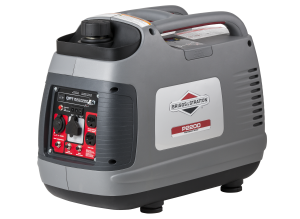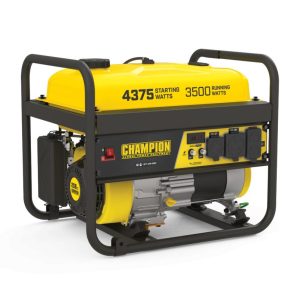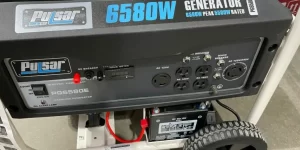Generator Won’t Start for These 16 Reasons (Troubleshooting)
When you need to start your generator, you probably don’t have access to electricity. So, it’s even more aggravating when it refuses to start.
I’ve included a list of typical starting issues and how to fix them to aid with your diagnostics.
If the generator isn’t getting enough fuel, air, and spark, it won’t turn on.
The air filter may be clogged, the choke may be set incorrectly, the on/off switch may be broken, there may be no gas in the tank, the fuel filter may be clogged, the fuel line may be clogged, the carburetor may be dirty, the spark plug may be broken, the engine oil may be low, or the fuel cap may be broken.
For vehicles with an electric starter, examine the battery, starter solenoid, and ignition switch.
In order to make repairs, set the generator on a level surface, disconnect the spark plug wire, and let the engine cool down. For information on how to operate and maintain your generator safely, consult the manual.
Table of Contents
Potential Causes of Your Generator’s Failure to Start
Generator with no gas
Insufficient gasoline in the generator’s tank prevents it from starting. You probably already know that. I only bring it up now because you could have overlooked it otherwise.
If you are using more fuel than usual, there may be a leak. In addition, your fuel gauge may be broken.
Check for fuel leaks or a broken fuel gauge if you run out of gas. Fix whatever breaks. Gas up the tank with some new gas. Two-cycle engines, like the one in your generator, require a blend of gasoline and oil as fuel.
Generator with stale fuel
The most common reason for a generator to stop working is stale gas. As early as 30 days after purchase, gas might start to degrade.
Most gasoline contains ethanol, which is a water magnet when it gets into the fuel system. Because the ethanol and water create a varnish that can clog fuel filters and damage other parts of the engine.
This compound, like the gas, eventually settles to the base of the storage container. The corrosiveness of this substance is extraordinary.
Keep these points in mind when purchasing, storing, and using gasoline to mitigate the negative effects of ethanol on a generator:
- Get yourself some new gas with an octane value of at least 87. (91 RON).
- Don’t ever fill up with gas that has more than 10% ethanol in it. Energy sources that don’t include ethanol are preferred.
- Within 30 days, all gasoline must be used.
- If you won’t be using the fuel within 30 days, you can keep it from deteriorating by adding a fuel stabilizer to it. (New gasoline requires a stabilizer before it may be used. The damage done by stale fuel won’t be undone by this.
- Keep gasoline in a certified fuel container, far from anything that could catch fire, including water.
If you discover stale gas in your generator, you should empty it out with a fuel siphon pump. When you add a fuel additive to fresh gas, it helps cleanse the fuel system, cuts down on moisture, and stabilizes the fuel.
- 2-Cycle Engines Run on a Blend of Gas and Special 2-Cycle Oil.
- Gasoline is used in a straight form in a 4-cycle engine.
Put the gas in the tank. After getting the generator going, let it run for 15 minutes to let the gas and stabilizer blend circulate through the fuel system.
A product I recommend is called Sea Foam Motor Treatment. Every time I fill up my gas tank, I use this product to mitigate the potential problems caused by ethanol. In addition, STA-BIL is a viable alternative.
Clogged Generator Fuel Filter
Either cleanse the fuel bowl and screen or substitute the fuel filter if it is clogged.
Clogged Fuel Line on a Generator
When fuel gets old, it can leave behind sticky deposits or dirt that can clog the fuel line and other parts of the fuel system. It’s important to examine the fuel line for any obstructions that might be preventing enough fuel from reaching the engine.
If you discover a clog in the fuel line, disconnect the generator. Compressed air should be blown through the pipe while spraying carburetor cleaning on the clog to help break it up.
Install a new gasoline line if you can’t get the fuel restriction removed.
Generator With A Dirty Carburetor
There is an explosion in the cylinder caused by the combination of air, gasoline, and spark that ignites the engine. The carburetor controls the ratio of fuel to air that is sucked into the cylinder.
To put it simply, if old fuel has clogged the carburetor’s fuel channels, then the generator will not start.
Once you’ve established that gas is reaching the carburetor but not the generator, the fix is obvious: just take it off.
Remove any buildup of varnish or deposits in the carburetor with a carburetor cleaner. Examine the float, float needle, and fuel jets in the carburetor to guarantee they are clean and in working order.
If you notice any broken pieces, you’ll need to use a carburetor rebuild kit or buy a new one.
A Generator with a Blocked Air Filter
Air filters are another component of a well-maintained system that serve to block dust and other particles from entering the system through the ventilation system. Engines can be severely damaged by even a minimal amount of dirt.
A generator air filter should be used constantly. It is recommended that this filter be inspected and cleaned on a regular basis throughout the year.
The first step in every new year should be to replace the air filter. The upkeep doesn’t end there. To maintain the filter functioning properly, it must be inspected and cleaned on a regular basis.
An extremely dirty filter can prevent the generator from starting, lead to overheating, and even ruin the engine.
If you have a foam air filter, you can clean it with water and a mild detergent if you notice that it has become clogged. After removing excess water, hang the filter to dry.
Some foam air filters, like those for an engine, need to be lightly soaked in clean engine oil in order to effectively trap the dirt, while others need not. If you are unsure what is necessary for your particular foam filter, see the user handbook.
You should get a new air filter if the one you have is tattered, has holes in it, or is a dark hue.
Replace the paper filter on your generator at least once a year, and more frequently in dusty environments.
Generator With Its Fuel Vent Blocked
The gas cap, or another component fitted atop the fuel tank, serves as an exhaust point for the tank’s contents. In order to maintain atmospheric pressure in the fuel tank, a vent is necessary.
If the fuel tank vent is blocked, the tank will develop a vacuum as fuel is used up. This blocks fuel from reaching the carburetor, rendering your generator inoperable.
Solution: If your generator won’t start, try starting it with the gas cap loosened or removed to see if it helps.
After you’ve tightened the cap and let it run for a time, if it suddenly stops working again, the vent may be clogged. The fuel tank air intake should be fixed immediately.
Generating with a Clogged Spark Arrestor
A metal screen called a spark arrestor is installed above the muffler to contain any stray sparks or hot exhaust particles. In order to avoid potential harm and fire, this screen is essential.
Inability to release hot air from inside the generator makes it difficult to start and run when clogged.
Take off the muffler’s spark arrestor screen. Make sure there are no tears or holes in the screen by giving it a thorough inspection. If this occurs, a new display will need to be installed.
If it is undamaged, you can clear off the soot with a little metal brush. When you’re done cleaning the screen, put it back on the muffler.
Generating Failure Due to a Faulty Spark Plug
Faulty spark plug symptoms include grime buildup, fractured porcelain, and pitted electrodes. Your generator won’t start up because of a lack of spark if you do this.
The deposits can be removed by cleaning the spark plug, provided the plug is otherwise in good shape and only slightly dusty. However, you should get a new spark plug if the tip of your current one is severely discolored or broken.
The spark plug gap must be adjusted in accordance with the manufacturer’s recommendations stated in the user’s guide. A misaligned spark plug gap or a disconnected spark plug wire can prevent the engine from starting.
Bad Generator Ignition Coil
Before you go looking for a faulty ignition coil, ensure sure your spark plug is in good shape. For the spark plug to ignite the fuel mixture and start the engine, voltage must first be supplied by the ignition coil.
Engines will not start if the spark plugs are not able to ignite because of faulty spark plugs or ignition coils.
It is recommended that an ohmmeter be used to test the ignition coil’s continuity. Breaks in continuity indicate that the ignition coil needs to be replaced.
Inadequate Generator Oil Level (4-cycle engine)
Inadequate engine oil prevents a generator from starting. A low-oil-level detector is included within the generator. If the oil level is low, the engine won’t start.
SOLUTION: Set the generator down on a level place to check the oil level. Take off the oil fill cap, then use a dry towel to remove the oil from the dipstick.
Do not tighten the cap on the oil fill tube after reinserting the dipstick. Take it out and check the oil level with the dipstick. Check that it’s within the entire range shown on the dipstick.
If it isn’t, you should adjust the oil level by draining or refilling it until it is.
When you check the oil level and see that it is correct yet the low oil light continues to illuminate, you may have a defective sensor. The generator should be taken to a service center for maintenance.
Incorrect Generator Choke Setting or Defective Choke Dial/Switch
Some versions of generators feature a control knob. It could be broken and unable to perform its normal activities.
A non-functioning generator choke adjustment dial or switch prevents the generator from starting.
The choke on other kinds of generators can be adjusted with a lever or knob. To ignite a cold engine, you must move the choke lever to the choke position.
If you want to keep your engine going, you’ll need to turn it to the “off” position.
Get in touch with a service center to find out if the issue is with the dial. If the generator still won’t start even with the manual choke lever or dial in the correct position, the choke plate may be jammed.
Recoil Problems in a Manually Started Generator
If the starter recoil is worn or broken, starting the generator will be difficult at best. Problems with starting can be caused by a number of factors, including a broken pulley, springs, or clips, as well as an unstrung rope on the recoil.
Sometimes all that’s required is a new set of recoil strings. On sometimes, you may need to repair or replace components of your recoil. Find out how much a complete recoil replacement will cost before you start replacing individual parts.
It may be more cost-effective to just replace the recoil assembly instead of dismantling it to fix individual parts.
Electric-Start Generator with a Defective Ignition Switch
On an electric-start generator, a faulty ignition switch could prevent it from turning over. If the generator’s electric start is broken, you can still start it by hand using the recoil.
The solution is to use a multimeter to check the switch and replace it if necessary.
Electric-Start Generator with a Dead Battery
Get the battery charged up. Battery charging is an option if the power supply is low. A new battery should be installed if the old one is unable to retain a charge.
Make that all of the wires and cables are securely connected and have adequate continuity.
Determine if the battery voltage is low and charge it if necessary. Change out a battery that isn’t holding a charge or has died.
Electric-Start Generator’s Starter Solenoid
A clicking or humming noise may be heard when you press the button or turn the key (depends on your model) to try and start your generator. Alternatively, you may notice that the wire is overheating and even smoking.
The solenoid may be broken if these symptoms appear. When the copper plate within a starter solenoid corrodes or the spring inside becomes too weak, the solenoid fails to turn over. It is also possible for the solenoid to fail due to a poor starter, a dead battery, or an unstable ground.
SOLUTIONS: Connecting the battery cable directly to the starter cable and the starter cable together may allow you to power the engine without utilizing the starter.
Exercise caution because it could potentially spark. Engine cranking without the solenoid present is indicative of a failing solenoid.
Before you go ahead and replace the solenoid, be sure there are no dangling wires or a lack of ground. All of these things have the potential to disrupt the solenoid’s normal operation.
The good news is that most electric-start portable generators also come equipped with a manual starter recoil for pull-starting. If you can get it going manually, you know the issue is with the electric starter.







